Earlier this year, Ford sent me a new (2021) F-250 pick-up with the also-new 7.3 liter monster motor to test drive; this week, I have the same basic truck, again – but this time, it’s a ’22 equipped with the 6.7 liter monster torque motor.
Call it the Battle of the Super Duties!
What It Is
The F-250 is Ford’s three-quarter-ton (2500 series) pick-up truck, one notch up in capability from the half-ton (1500 series) F-150. The two look similar – because the current half-ton F-truck emulates the Super Duty appearance of the F250, including the tall bed walls and such that used to be specific – and exclusive to – the latter.
But looks only pull so much.
If you need to pull at least 15,000 pounds then you’ll probably want the F-250 – which can pull as much as 22,800 pounds via gooseneck, if equipped with the monster torque (1,050 ft.-lbs. of it) 6.7 liter turbo-diesel Powerstroke V8.
There is also something else to consider.
Actually, two things.
Unlike the F-150, the F-250 is available with your pick of all three of its available engines – which are all V8 engines – with any trim configuration, including the base XL trim. The F-150’s strongest engine is a V6 (with two turbos) that isn’t available in the lower-priced XL and XLT trims.
Prices for the F-250 start at $34,230 for the base XL trim regular cab with 2WD and an 8.2 foot bed. This one comes standard with a 6.2 liter V8 that makes 385 horsepower – that isn’t available in the half-ton F150.
Two other V8s are available, optionally.
The first is a gas 7.3 liter V8, the biggest V8 Ford has put into a truck or anything else since the old 460 V8 of the ‘70s and ‘80s. But this one makes 430 horsepower – which is about 200 horsepower more than the last 460 V8 made.
Opting for this engine adds $2,045 to the price.
The second is physically smaller – but also much bigger.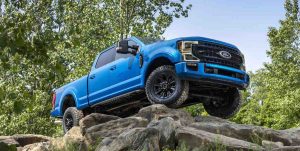
This one being the 6.7 liter Powerstroke turbodiesel that makes more than twice the torque of the 7.3 liter gas V8.
And 475 horsepower.
That’s how you pull 22,800 pounds.
It does add $10,495 to the price of an XL. Even so, you’re still looking at just shy of $45k for a truck that can do serious work – and thereby pay for itself.
A 12 inch LCD touchscreen is available with Lariat, King Ranch and Platinum trims.
What’s Good
Even the standard engine is still a V8.
Optional V8s available in every trim/bed/cab combo.
About the same length and width as a same-configuration half-ton F-150 but much more capable.
What’s Not So Good
Like the F-150, the F-250 has an aluminum body that’s lighter than steel but easier to dent – and harder to fix.
No manual transmission available with any of the V8s.
Both the F-150 and F-250’s ride height and bedwalls are so high it’s not easy to reach into the bed – even for a man well over six feet tall.
One of the chief draws of current 2500 series trucks like the F-250 is that these are the last trucks on the market that still come standard with V8 engines.
Some of the latest 1500 series trucks – like the just-redesigned Toyota Tundra – no longer offer V8s at all because of the ever-increasing pressure of government regulations regarding gas mileage – and greenhouse gas “emissions.”
Smaller engines achieve higher MPG ratings – on government fuel efficiency tests. And smaller/turbocharged engines “emit” less gas . . . when they’re not under boost.
But many truck buyers still want – still need – a V8.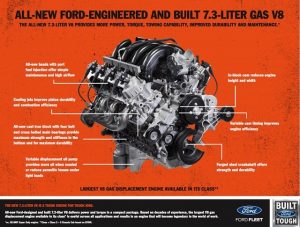
Especially a big one – like the F250’s standard 6.2 liter V8, which makes 385 horsepower and 430 ft.-lbs. of torque.
This V8 has dual overhead cams – but no turbos. It’s paired with a six speed automatic with just two overdrive ratios. It is becoming hard to find automatics with fewer than eight speeds and less than three or more overdrive gears – once again because of the pressure being applied by the federal regulatory apparat. The extra overdrives helping to squeeze out a couple of MPGs – the cost of doing so paid by the buyer.
Equipped with its standard V8 the F-250 is rated to pull up to 15,800 pounds (with gooseneck) which easily surpasses the twin-turbo V6-powered F-150’s maximum tow rating of 14,000 lbs. Which the F-150 can only pull if you spring for a higher than XL/XLT trim – because you can’t get the 3.5 liter Ecoboosted V6 in those trims in the F-150.
The F-250’s optional engine is a 7.3 liter V8 that makes 430 horsepower and 475 ft.-lbs. of torque at 4,000 RPM.
This engine is a pushrod engine – no overhead cams. Not direct-injected. It is a simpler engine, with fewer parts that’s a lot like the big block V8s that used to be commonplace under the hoods of big trucks. The max you can pull with this engine – which is paired with a ten speed automatic transmission – is about the same as you can pull with the 6.2 engine – 15,000 pounds conventionally; 19,500 with gooseneck – but with almost 50 more horses under your right foot.
For only just over $2k extra.
There’s one more engine to consider. If you can afford to. It’s the F-250’s strongest engine – though not its largest engine.
It’s a 6.7 liter turbodiesel V8 that makes 475 horsepower and a copy-editor-checking 1,050 ft.-lbs. of torque at 1,600 RPM. Equipped with this beast, an F-250 can pull 20,000 pounds conventionally and 22,800 with a gooseneck.
This engine also features an exhaust brake and has the ability to burn B20 diesel (emissions regs that apply to “light duty” trucks don’t yet apply as fiercely to heavy-duty trucks). So equipped, you can also drive some 600 miles on a full tank (34 gallons) which is comparable to how far you can drive a Prius hybrid – while towing several of them.
None of the F-250’s engines are available with a manual transmission – which used to be as de rigueur in big trucks as big V8s. The reason they’re no longer available is the same reason V8s are becoming unavailable in half-ton trucks (which are also all automatic-only):
The regulatory apparat.
It is harder to fine-tune an engine for highest mileage and lowest “emissions” when the driver is in control of the shifting. Automatics can be programmed to get the most – and least – out of an engine and that’s why manuals have all-but-disappeared.
On The Road
If you test drive an F-250 with the Powerstroke diesel V8 back to back with one powered by the 7.3 V8 you will immediately notice a number of differences.
The diesel feels stronger, sooner – as you’d expect with four figures’ worth of torque available almost immediately.
It’s also quicker – without feeling it.
The bigger V8 feels like it’s pulling harder – even though it can’t pull as much. Or get you there as quickly. 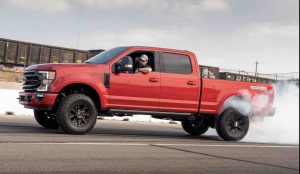
It’s an interesting experience.
Floor it and the Powerstroke doesn’t rev – much. It’s a diesel, of course. Redline is around 4,000 RPM vs. over 6,000 for the V8. But you don’t need to rev when you’re making 1,000-plus ft.-lbs. of torque at fast idle – and more horsepower than the gas V8 makes however much it revs.
This is a beautiful – and quiet – thing.
The diesel endows the F-250 with explosive acceleration – just over 7 seconds to 60 being pretty impressively explosive for anything weighing almost 7,000 pounds without a driver behind the wheel – without afterburners. It simply bullies its way forward – and down the road – like a 320 pound linebacker sacking a quarterback.
An F-250 with the 7.3 monster motor is close behind – but makes more of an issue of it. More revs and – interestingly – more noise. The diesel is remarkably quiet. The gas engine – having to rev – is louder under full throttle.
It also can’t go nearly as far.
EPA does not publish city/highway numbers for heavy-duty trucks like the F-250 but I can tell you – having driven both an F-250 with the 7.3 gas engine and an F-250 with the 6.7 diesel engine – that the latter goes much farther on a full tank, around 600 miles on 34 gallons which – rough math – works out to circa 17 MPG.
The gas V8’s mileage being closer to 10.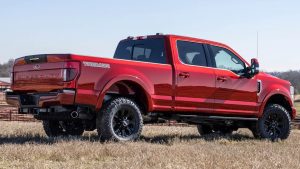
At The Curb
No matter which big V8 you end up with, you will end up with a big truck. More precisely, a tall truck.
An F-250 regular cab is only marginally longer (231.8 inches) than an F-150 regular cab (227.7 inches) and both are just as wide (105.9 inches, with the oversized extending side mirrors) which means they both need every inch of road, on either side. Smacking mirrors with another big truck coming at you the other way is more likely when you’re this wide – and many roads aren’t much wider.
The tested Tremor model seems even bigger – because it is even taller. Because it stands on 35 inch knobbies and has a factory lift kit that ought to include an oxygen feed. On the one hand, this thing has so much clearance (and capability) it could probably crawl over Mount Rushmore. On the other hand, it is so big it is constrained by the amount of room available off-road, which is often not much. In terms of tenacity, this thing is the peer of Wrangler Rubicons (and new Broncos). But its bigness imposes limits.
I’m a big guy. I’m a taller guy than most guys. But even a six-foot-three-inch-tall guy like me can’t touch the Tremor’s bed floor without standing on a step ladder. This means needing to use the step ladder that’s built into the tailgate. But even though this helps you get in, it remains a little difficult to get stuff out – because of how far that drop is.
My ’02 Nissan Frontier is a toy compared with this Bruiser. It does not pull even a fourth of what this truck can. However, I can touch the bed floor without using a step ladder – and it’s easy to grab stuff I put into the bed out of the bed – without using a step ladder or a loading dock.
The F-250, of course, is a Super Duty truck and such trucks have traditionally been higher up than other trucks. But then the Super Duty look caught on – and now even light duty trucks like the F-150 emulate the high-tall themes that look rugged but make loading and unloading more of a challenge.
You can seat five big men comfortably in this big truck – two up front, three across in back. It’d be nice if you could seat six – three up front – which would be possible if the truck offered a bench seat rather than buckets separated by a console. Or a console you could flip back that turned into a jumpseat. This would also allow your significant other to snuggle up closer.
All that’s missing then being three on the tree!
The Rest
While the F-250 is available with a large (12 inch) touchscreen similar to the one available in the F-150, it is not obligatory. Even in the Tremor. Which – for a ’22 model year truck – is still happily truck-like. It has straightforward manual/hand controls for most major functions – including the four-wheel-drive settings – as well as an analog gauge cluster. You can even still roll down the windows manually, if you prefer. But it is also a luxurious truck, which can be outfitted with a Bang & Olufsen ultra-premium audio rig and rides like a jacked-up Cadillac.
My ’02 Nissan rides like a truck – even though it’s not even half the truck this thing is.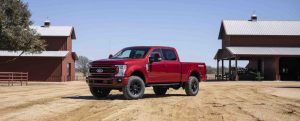
The one worry is the Ford’s aluminum body – including the bed. Aluminum has many merits, including light weight and better corrosion resistance relative to steel. But it also has some negatives, especially in a truck context.
Aluminum is easier to bend – and harder to fix. Trucks tend to get bent, in the course of work. A steel-bodied truck is more dent resistant and can often be bent back into shape – kinda-sorta – using a come along and rubber hammers. Damaged aluminum often requires the services of an expert and that can cost more than a come-along and rubber hammers.
The Bottom Line
You want a standard V8? More V8? A truck like the F-250 has both.
And then some.
. . . .
Got a question about cars, Libertarian politics – or anything else? Click on the “ask Eric” link and send ’em in! Or email me at EPeters952@yahoo.com if the @!** “ask Eric” button doesn’t work!
If you like what you’ve found here please consider supporting EPautos.
We depend on you to keep the wheels turning!
Our donate button is here.
If you prefer not to use PayPal, our mailing address is:
EPautos
721 Hummingbird Lane SE
Copper Hill, VA 24079
PS: Get an EPautos magnet or sticker or coaster in return for a $20 or more one-time donation or a $10 or more monthly recurring donation. (Please be sure to tell us you want a magnet or sticker or coaster – and also, provide an address, so we know where to mail the thing!)
My eBook about car buying (new and used) is also available for your favorite price – free! Click here. If that fails, email me at EPeters952@yahoo.com and I will send you a copy directly!


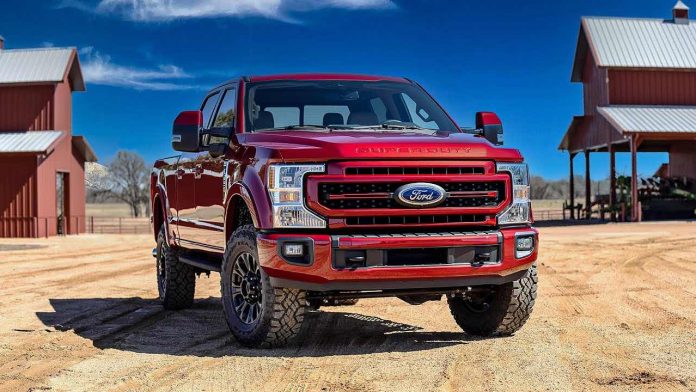

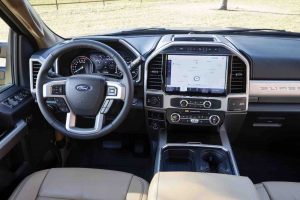

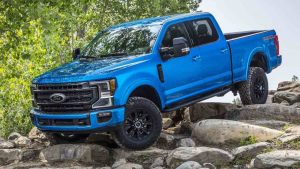
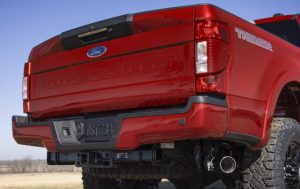








I have two friends who have bought F-250’s this year to pull campers.
One bought a 2021 with the PowerStroke to pull a 29′ Airstream. One bought a 2022 with the “Godzilla” 7.3L gasser to pull a 5th wheel. He custom ordered it with the bench seat in the front, since they have 4 kids still at home. So the front bench IS an option, Eric.
Beautiful machines that make me jealous in my F-150!
With all that extra power, there ought to be a trim option (even if it’s a luxury trim) with even thicker steel body instead of aluminum. Heck, why not heavy stainless steel, painted of course? Then nothing would ever rust. If only the market had a say…
GM is bringing out a 10.4 litre 632 c.i. V8 crate engine, NA, 1004 HP. $30,000.
Sounds great, but you can buy 3 Ford Diesel motors for that price.
And GM can’t produce a transmission that would handle that 10.4L torque.
But Ford could, and probably already does.
So, hey, you do you,but the real work world gives Ford the win.
Again.
I keep hearing about the new 632 crate engine, but am I correct that it’s for drag racing only (i.e. it’s not set up to be able to run on the road for everyday driving)?
Hi Dood,
It’s not legal – technically – to install it in a street driven car subject to emissions controls. I won’t tell if you won’t!
As supposedly tough and powerful as these newer generation trucks are purported to be, that is merely a relative discription comparatively. There is no way these aluminum and plastic 4wd computers will ever compare to the almost lost generation of REAL trucks, which ended around 1997-98 for all brands. Case in point, my ’88 f250 460 5sp 4wd, when I got it it had 450k miles on original engine and trans, was an oilfield truck for years logged over 50k miles in 4 low alone, with chains on all 4 tires, pulling a loaded triple axle trailer everywhere, at nearly a half million miles it towed a 60ft single wide mobile home 30 miles without breaking a sweat. Not a one of these new trucks could take a tenth of what that truck went through,let alone do it for 30 years straight.
Well, it is a Ford…
What did you expect?
If it was a GM, you’d have been through about half a dozen transmissions.
And who knows how many engine overhauls.
And I’m not a fanboy of any company, I just like what works.
If I can afford it, my next vehicle is to be a diesel 2500 to tow around my camper.
Figure a travel trailer wont ever break a diesel, but I do worry about emissions regs making that not an option.
My job requires dealing with a lot of Contractors that own 5-20 of these 250/2500+ type trucks, and run them 4-8 hours a day, every day. They all used to be diesel, not anymore. They say they don’t last with all the emissions stuff on them, and cost a fortune to own/run. Most I know are going with the new larger gas engines.
One feature new trucks have that I’m kinda jealous of is the integrated brake controller for a trailer. One feature I’m not at all jealous of is the price tag.
I’d like to know how well these aluminum rigs age corrosion-wise as the years pile up. My 30 years in commercial aircraft, corrosion control in design/plan/build is a constant problem.
Dissimilar metals invite galvanic corrosion and just add road deicer to get that ball rolling. Steel frame, door hinges, motor mounts? Better hope they isolate and or seal those and any other steel parts or your $50K rig will end up a mess of aluminum oxide.
How many of these will be bought to tool around Suburbia without even a 2X4 ever making it into the bed? The parking lot at work is filled with these gargantuan trucks, and I wonder if they are ever used for their purpose to haul stuff, or are they a virtue signaling device for conservatives?
Im happy with my 2008 Ranger. It does everything I need it to do, but couldn’t do half the things these things can, not that I personally need it to anyway.
As Eric alluded to, these behemoth trucks are too tall for a lot of ordinary contractor work. Great for pulling! Terrible for an ordinary tradesmen who will need to reach into the bed or use it regularly for anything besides a gooseneck. A Ranger or a S-10? Those are great for that kind of stuff and run forever and are cheap to fix.
Eric,
So, the F150 is back to being a full-sized pick-up? That is a good thing- as that had been the way it always was up until c.1998 when they downsized the F150, and thus had no full-sized 1/2 ton truck for the last 20 years, eh? A lot of people who needed/wanted a full-size truck have had no options during those years, but to get an F250, even if they didn’t need it’s capabilities, merely because there were no full-size half-tons. Between that, and the 7.3 gas injun, at least Ford has some sense still. (Considering the boondoggles that all of the modern diesels have become, anyone would do well to avoid those… Which is why they came out with the 7.3 gas, because so many fleet buyers refused to buy the diesels anymore, since they were so complex, unreliable and expensive to repair, while offering scant mileage improvements over a gas engine with all of the emission controls these days)
Eric – you think they will ever cover the bed and make this thing into an SUV for moms to drive kids to school!?
Hey Nasir,
They did that between 2000-2005 -It’s called an Excursion. I drive one! They’re awesome! Mine has the 10-cylinder gas engine. Parts are interchangeable with those of my ’99 F250…as the Excursion is essentially an F250 with the bed covered and upholstered.
Interesting Nunzio – quite nice. it seems like theres quite a bit of demand for these things…. almost 20 year old cars with over 100K still listed for 30-50k !!
I guess the people want what they want !
I have one myself.
I bought it for passenger protection issues.
And I only got it because Cement Trucks are slow,
have limited seating, and are hard to park.
In a former life, in the insurance industry, I observed that bigger vehicles always “won” in accidents. ALWAYS. And the passengers always walked away with minimal or no injuries, compared to whatever injuries the other vehicles occupants suffered.
People “want” them because people have learned that these vehicles protect you and your passengers like nothing else, short of Cement Trucks.
And all vehicles are more disposable than people.
But, YMMV….
Hi Nasir,
No – because it’s not 1995 anymore and they can’t “get away” with it. The Excursion Nunz mentions was built when they could. I expect even these heavy-duty trucks to be gelded, soon.